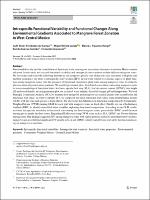| dc.contributor.author | Torres Fernández del Campo, Judit | |
| dc.contributor.author | Olvera Vargas, Miguel | |
| dc.contributor.author | Figueroa Rangel, Blanca L | |
| dc.contributor.author | Cuevas Guzmán, Ramón | |
| dc.date.accessioned | 2022-11-25T19:08:54Z | |
| dc.date.available | 2022-11-25T19:08:54Z | |
| dc.date.issued | 2022 | |
| dc.identifier.uri | https://repositorio.catie.ac.cr/handle/11554/12151 | |
| dc.description.abstract | Functional diversity and the contribution of functional traits in mangrove ecosystems dynamics in western Mexico remain unknown. In this study, we assessed functional variability and intraspecific trait variation in three different mangrove zones. We developed and tested the following hypothesis: (i) mangrove species vary along trait axes associated with plant size and leaf economics. (ii) there is intraspecific trait variation (ITV) in leaf traits related to economic aspects of plant function among mangrove zones. (iii) the presence of functional variation in plant traits among mangrove zones is related to physicochemical ground-water gradients. We used 65 permanent plots, distributed across three contrasting mangrove zones to assess morphological functional traits: leaf area, specific leaf area (SLA), leaf dry-matter content (LDMC), tree height (H) and wood density; in each permanent plot, we recorded: water salinity, dissolved oxygen, pH and temperature. We used Principal Component Analysis (PCA) to examine how mangrove and mangrove-associated species were assembled in the functional trait space; in order to identify ITV, we compared the mean functional trait values using general linear models (GLM) with the zone and species as fixed effects. We also tested for differences in functional composition by Community-Weighted Means (CWM) running GLM for each trait with mangrove zones as fixed effect. Finally, we ran a Redundancy Analysis (RDA) to identify interstitial water variables explaining functional composition. According to our GLM results, we found intraspecific variability in functional traits among the three mangrove zones; particularly LDMC varied the most among species inside the three zones. Regarding GLM results using CWM, traits such as SLA, LDMC and H were different among zones. Our findings suggested ITV among mangrove zones with spatial patterns related to interstitial water variables; mangrove species exhibited significant ITV mainly in SLA and LDMC; salinity and pH were relevant to the functional ecology in mangrove ecosystems. | es_ES |
| dc.format.extent | 11 páginas | es_ES |
| dc.language.iso | en | es_ES |
| dc.publisher | Wetland | es_ES |
| dc.relation.ispartof | Wetland Ecology | es_ES |
| dc.relation.uri | https://doi.org/10.1007/s13157-022-01635-6 | |
| dc.subject | ECOSISTEMA | es_ES |
| dc.subject | ECOSYSTEMS | es_ES |
| dc.subject | MANGLES | es_ES |
| dc.subject | MANGROVES | es_ES |
| dc.subject | ANALISIS DE AGUA | es_ES |
| dc.subject | WATER ANALYSIS | es_ES |
| dc.subject | ANATOMIA DE LA PLANTA | es_ES |
| dc.subject | PLANT ANATOMY | es_ES |
| dc.subject | HABITOS DE CRECIMIENTO | es_ES |
| dc.subject | PLANT HABIT | es_ES |
| dc.subject | MÉXICO | es_ES |
| dc.subject | INTRASPECIFIC FUNCTIONAL VARIABILITY | es_ES |
| dc.subject | INTRASPECIFIC TRAIT VARIATION | es_ES |
| dc.subject | INTERSTITIAL WATER PROPERTIES | es_ES |
| dc.subject | ENVIRONMENTAL GRADIENTS | es_ES |
| dc.subject | COMMUNITY-WEIGHTED MEANS | es_ES |
| dc.subject | GENERAL LINEAR MODELS | es_ES |
| dc.subject.other | Sede Central | es_ES |
| dc.title | Intraspecific Functional Variability and Functional Changes Along Environmental Gradients Associated to Mangrove Forest Zonation in West-Central Mexico | es_ES |
| dc.type | Artículo | es_ES |
| dc.creator.id | https://orcid.org/0000-0001-8765-9382 | es_ES |
| dc.identifier.status | restrictedAccess | es_ES |


